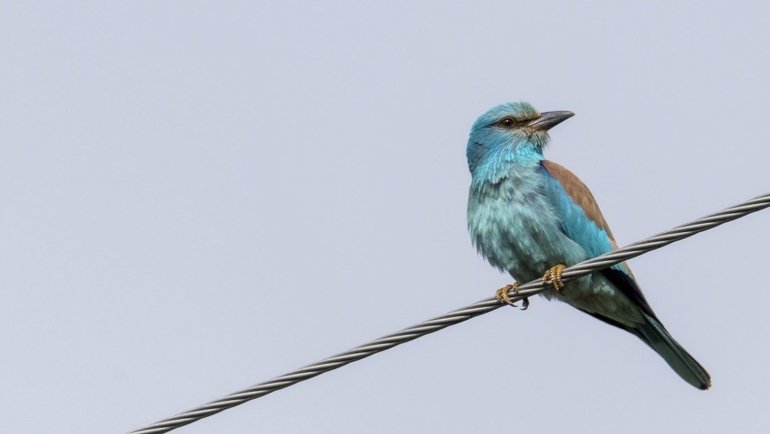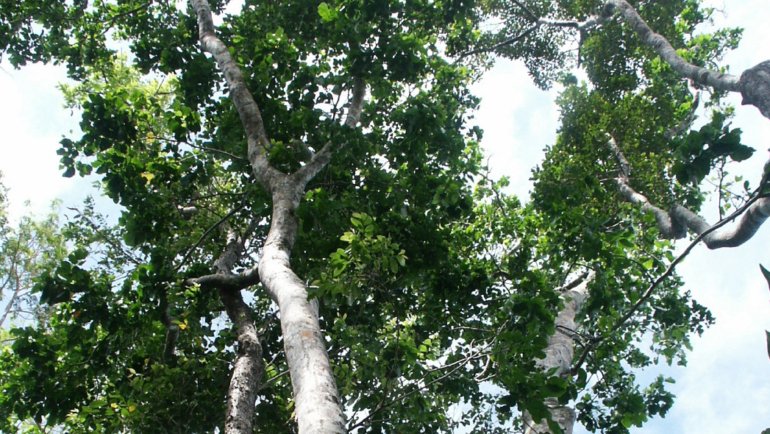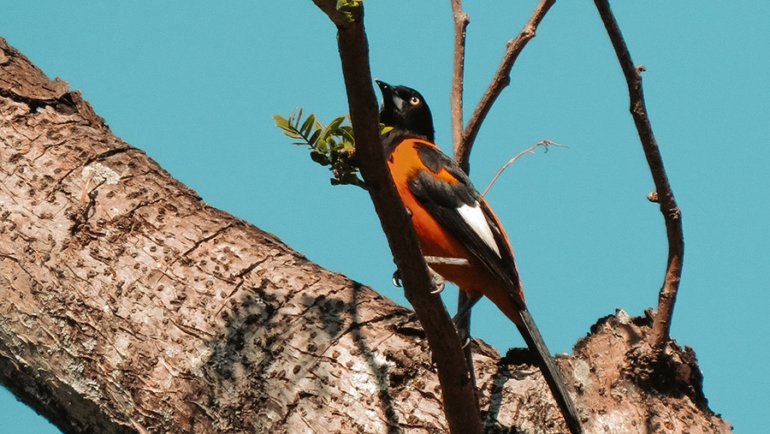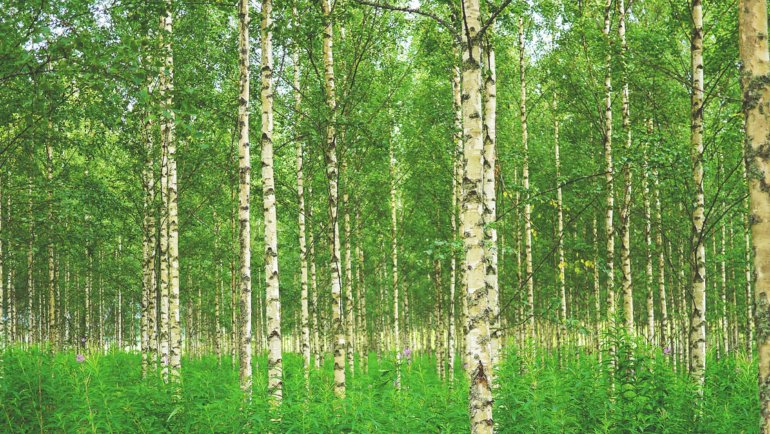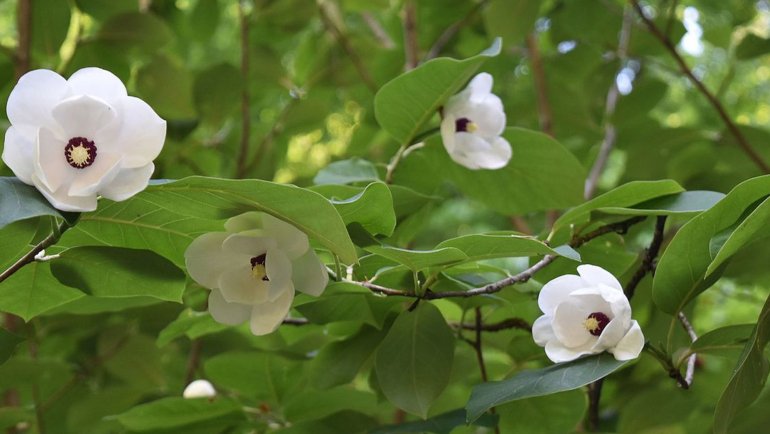Have you ever wondered about the fascinating tapestry of animals that inhabit our world, each symbolizing the culture and spirit of their respective countries?
Well, today, we are delving deep into the heart of Cambodia, a land of mystique and timeless traditions, home to the enigmatic kouprey (Bos sauveli)—a possibly extinct species, shrouded in mystery and intrigue.
A creature of the forests, known to the local Khmer population for thousands of years as the “forest ox”, the kouprey is as much a symbol of Cambodia’s rich biodiversity as it is a reminder of the urgent need for conservation.
Intrigued? Let’s discover together the tales of this elusive creature, its significance, and the whispers of its existence that still permeate the lush landscapes of Cambodia. And, who knows, you might find yourself entwined in the quest to unravel the mysteries of the kouprey—a symbol of Cambodia’s enduring spirit.
Quick Info About The Kouprey
| Scientific Name: | Bos sauveli |
| Average Size: | 5.6 to 6.3 ft (170–190 cm) at the shoulders |
| Average Weight: | 1540–1980 lbs (700–900 kg) |
| Geographical Range: | Formerly Southeastern Thailand, Southern Laos, Western edge of Vietnam, Northern Cambodia; historically up to Yunnan, China |
| Habitat: | Open grassland, dense and open canopy forests with grassy glades, waterholes, and salt licks |
| Conservation Status: | Critically Endangered, possibly extinct (IUCN Red List) |
Meet The Kouprey, National Animal of Cambodia
Enveloped in the lush, emerald canopies and the undulating landscapes of Cambodia is the elusive kouprey, a creature of enigma and grace. Picture this: A majestic bovine, size oscillating between that of the gaur and banteng, its stature robust, bearing the marks of the wild, untouched terrains it once roamed.
Adult koupreys grace the landscapes with bodies measuring between 5.6 and 6.3 ft at the shoulders, their frames robust, weighing between 700 and 900 kg.
The sexual dimorphism in koupreys is quite significant. The males, with their horns wide-set, reminiscent of the wild yaks, arch forwards and upwards, fraying at the tips, portraying a majestic silhouette against the Cambodian sunset. In contrast, the females flaunt horns spiraling upwards, akin to a lyre’s frame.
What role does this majestic creature play in the labyrinth of ecosystems, you ask? The kouprey, primarily a grazer, harmonized its existence with the diverse fauna, balancing the flora and contributing to the ecological equilibrium of its habitats.
While the information on its predators remains sparse, the pivotal role it played in the ecological symphony cannot be overstated. It’s a creature that painted the ecological canvas of Cambodia with its distinctive strokes, contributing to the biodiversity and ecological balance of its rich landscapes.
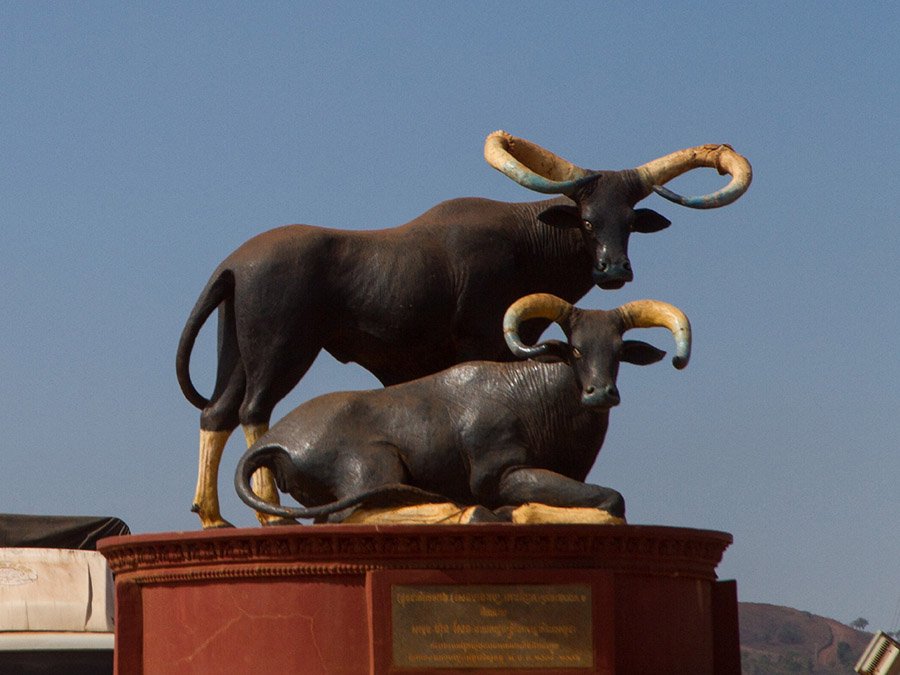 Source: Wikimedia Commons
Source: Wikimedia CommonsWhere Does/Did The Kouprey Live?
The whispers of the kouprey echo in the varied terrains it once called home, a melange of open grasslands and the dense canopies of Cambodia’s lush forests, featuring grassy glades, waterholes, and salt licks, crafting a sanctuary for this unique species.
This landscape, with its symbiotic confluence of flora and fauna, encapsulates the essence of the kouprey’s existence, a reflection of its adaptive and resilient spirit.
The geographical footprint of the kouprey was once expansive, with its shadows lingering from southeastern Thailand, through southern Laos, along the western edge of Vietnam, and centering in the heart of northern Cambodia.
The archaeological whispers even hint at its presence as far north as Yunnan, China. Each terrain, with its unique climate and environment, cradled the kouprey, contributing to its mystique and allure, and shaping its interactions with the diverse ecosystems it inhabited.
Why and When Did The Kouprey Become The National Animal of Cambodia?
The kouprey, symbolizing the mysterious and the enigmatic, resonates deeply with the cultural ethos of Cambodia. It is more than just an animal; it is a symbol, a cultural tapestry interwoven with the threads of Cambodian heritage and national identity. But why was such an elusive, possibly extinct creature bestowed with the honor of becoming Cambodia’s national animal?
The kouprey was crowned as the national animal in the 1960s by the king of Cambodia and was further honored as the ‘national mammal’ in a 2005 royal decree.
It represents a living connection to Cambodia’s rich and diverse ecological heritage. Its designation as the national animal is, perhaps, a silent ode to the inherent resilience and the untamed spirit of Cambodia, contained in the kouprey’s majestic and wild demeanor.
While the kouprey carries immense symbolic weight, its status has sparked debates and reflections within the conservation and political spheres.
The animal’s potential extinction has presented a conundrum, with Robert Timmins, the lead author of the IUCN assessment, opining that the declaration of its extinction carries a stigma and could be interpreted as a failure in conservation management and governance, and, by extension, a political failure.
The reluctance to affirm its potential extinction may reflect a hesitancy to confront the loss of a symbol so deeply intertwined with national identity. It underscores the complex interplay between conservation, national symbolism, and politics, where the fate of a species is intertwined with the cultural and political narratives of a nation.
Where is The Kouprey Featured in Cambodia?
The image of the kouprey, reminiscent of the landscapes it once roamed, is etched into the daily life and the national consciousness of Cambodia. It is a constant companion, its silhouette gracing stamps and company logos, its name echoing in military exercises, and its spirit animating the country’s national football team, aptly nicknamed ‘Kouprey’.
The kouprey stands as a sentinel in the form of statues at the driveway of Cambodia’s national zoo, and on roundabouts at Phnom Penh’s historic Wat Phnom pagoda and in Senmonorom town. Each representation is a testament to its enduring significance and a visual reminder of its symbolic resonance in the collective Cambodian psyche.
These depictions are more than mere illustrations; they are narratives, telling tales of a creature that embodies the resilience, the mystery, and the untamed beauty of Cambodia.
They serve as silent narrators, whispering the stories of the kouprey, keeping its spirit alive in the hearts and minds of the Cambodian people, reminding them of their ecological heritage and their interconnectedness with the diversity of life that calls Cambodia home.
Names of The Kouprey
The kouprey is endowed with several names, each narrating a different facet of its being. It is colloquially known as the ‘forest ox’, a name emanating from its primary habitat and the Khmer word ‘kouprey’ which literally translates to the same. This creature is not just a biological entity but a cultural icon, reflecting in its names the narratives and traditions of the local populace.
It also answers to the scientific name, Bos sauveli, a tribute to its discoverer. In various regions and local dialects, the names may vary, condensing the diverse perceptions and relationships the different communities share with this animal. The myriad of names, whether scientific, local, or folk, illustrates the multifaceted identity of the kouprey, weaving together strands of biology, ecology, and culture.
Is The Kouprey Endangered?
The enigmatic kouprey is listed as Critically Endangered and is possibly extinct by the IUCN Red List, with the conservation community embroiled in a desperate race against time to ascertain its existence. The last credible sighting of this elusive creature was recorded in 1969, making every effort to locate it akin to seeking a ghost in the wilderness.
The reasons for its decline are numerous, from relentless hunting to habitat loss, reflecting the broader ecological crisis facing our planet. The unconfirmed status of its existence has ignited extensive research and conservation initiatives, hoping to either rediscover this ‘grey ghost’ or at the very least, to elucidate the circumstances leading to its decline and possible extinction.
Conservationists and researchers are weaving together innovative strategies, utilizing technology, and engaging local communities in a bid to unearth any signs of the kouprey’s presence, or to glean insights from local knowledge and folklore that might point towards its habitat or behavior.
Interesting Facts About The Kouprey
- Rare Sightings: The kouprey’s elusive nature has rendered it a near-mythical entity, with no confirmed sightings for more than half a century.
- Cultural Icon: Despite its elusive existence, the kouprey permeates Cambodian culture, reflecting in stamps, company logos, and even lending its name to the national football team.
- Symbolic Dilemma: The potential extinction of the kouprey poses a delicate conundrum, intertwined with national identity, conservation, and politics, revealing the intricate narratives surrounding symbolic species.
- Distinctive Horns: The kouprey’s horns are remarkable, with males showcasing widely set horns resembling those of wild yaks, and females flaunting spiraled ones, reminiscent of a lyre.
- Large Dewlaps: Bulls develop large dewlaps as they age, reaching lengths so considerable in some cases, that they drag along the ground.
- Diverse Habitat Range: The kouprey once roamed across diverse landscapes, from southeastern Thailand to southern Laos, and northern Cambodia, painting a picture of its ecological adaptability and range.
- Mystery in Silence: The unknown status of the kouprey acts as a silent reminder of the mysteries nestled within the intricate web of life and the undiscovered tales lurking in the whispers of the wild.
Other Beautiful Animals Native To Cambodia
- Giant Ibis: This endangered bird species is the national bird of Cambodia and represents one of the most important bird species in the country.
- Indochinese Tiger: An elusive and critically endangered subspecies of tiger, which calls the dense forests of Cambodia home.
- Irrawaddy Dolphin: This vulnerable dolphin species can be spotted in the freshwater rivers of Cambodia, bringing a sense of allure and wonder to its waters.
- Pileated Gibbon: Characterized by its distinct vocalizations and agile movements, this primate is a vital component of Cambodia’s rich biodiversity.
- Asian Elephant: The majestic Asian Elephant roams Cambodia’s landscapes, symbolizing strength, wisdom, and harmony with nature.
Frequently Asked Questions
Is the kouprey Cambodia’s national animal?
Yes, the kouprey is indeed the national animal of Cambodia, representing a significant part of Cambodia’s heritage and cultural identity.
Why is the kouprey important to Cambodia?
The kouprey is symbolic of Cambodia’s rich biodiversity and cultural heritage. Its presence in various aspects of Cambodian culture, from stamps to logos, reflects its enduring significance to the country.
Are there any conservation efforts in place for the kouprey?
There have been numerous conservation efforts aimed at determining the existence and status of the kouprey, although its elusive nature has made these efforts challenging.
Can the kouprey still be found in the wild?
There has been no confirmed sighting of a kouprey since 1969, and it is listed as possibly extinct by the IUCN Red List. However, the lack of definitive proof of its extinction keeps hope alive among conservationists.
Why are there controversies regarding declaring the kouprey extinct?
Declaring the kouprey extinct has political ramifications and is seen as a symbol of failure in conservation and governance, contributing to controversies regarding its status.
Is the Giant Ibis also a symbol of Cambodia?
Yes, the Giant Ibis is the national bird of Cambodia and, like the kouprey, represents the unique and diverse fauna of the country.
